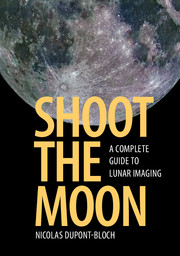Book contents
- Frontmatter
- Dedication
- Contents
- Preface
- 1 Introducing lunar imaging
- 2 Choosing your imaging equipment
- 3 Adapting your imaging device to the instrument
- 4 Tuning your telescope for lunar imaging
- 5 Wide-field lunar imaging
- 6 High-resolution lunar imaging
- 7 Essential image processing
- 8 Advanced image processing
- 9 Making 3D lunar images
- 10 Measuring and identifying lunar features
- 11 Photogenic features of the Moon
- 12 Naming, archiving, printing, and sharing lunar images
- Appendix 1 Maps of the Moon, the Lunar 100, and other targets
- Appendix 2 Webpages, books, and freeware for the Moon
- Appendix 3 Figure data
- Index
- Frontmatter
- Dedication
- Contents
- Preface
- 1 Introducing lunar imaging
- 2 Choosing your imaging equipment
- 3 Adapting your imaging device to the instrument
- 4 Tuning your telescope for lunar imaging
- 5 Wide-field lunar imaging
- 6 High-resolution lunar imaging
- 7 Essential image processing
- 8 Advanced image processing
- 9 Making 3D lunar images
- 10 Measuring and identifying lunar features
- 11 Photogenic features of the Moon
- 12 Naming, archiving, printing, and sharing lunar images
- Appendix 1 Maps of the Moon, the Lunar 100, and other targets
- Appendix 2 Webpages, books, and freeware for the Moon
- Appendix 3 Figure data
- Index
Summary
Being bright, large, and easy to aim at, the Moon is probably the first celestial object we observe with our naked eyes, binoculars, or a telescope. Usually, we move on to observing planets, stars, and then deep-sky objects. Most of us take a simple and occasional glance at lunar craters when we have no more objects to observe, no more astrophotograpy to do, after a nebula has set in the West and before a planet rises in the East. Furthermore, the Moon is very bright – a continuous spectrum, drowning the faint light of elusive galaxies. And, after having appreciated some dramatic craters and beautiful sharp mountain peaks, who could honestly be interested in these countless regular small craters, all these strange features whose names we cannot remember? At the same time, the Universe is a living, changing place: Jupiter shows ever-changing clouds, novae or comets can suddenly appear, and even numerous diffuse nebulae can be imaged from a light-polluted suburb with appropriate filters. That's why I didn't seriously look at the Moon for years – until I observed it through a small, professional telescope, during a cold night in town.
The image was incredibly sharp, with such a contrast that I suddenly understood that I could directly see the bare soil of another miniature “planet,” with a variety of rocks, topographic features, grazing impacts, bright or dark areas showing the evolution and history of a whole world. Of course, we all want to see smaller and smaller details on the Moon, such as craterlets, wrinkle ridges, domes, or channels, but large areas showing high contrast also provide major hints to understand the lunar soil: they show ancient lava fountains and blasts, the age of lunar “seas” (maria) and their mineralogical composition.
The Moon is actually an open book, telling the history of the whole Solar System to whoever wants to read it through a simple eyepiece. Geology, volcanism, fractures, impacts, giant cliffs, magnetic mysteries beneath strange surface features, overlapping or negative craters, curved mountains … Although there are no frontiers on the Moon, its differentiated landscapes clearly show that a history involving a huge variety of events has occurred, and the evidence remains there to be observed.
Information
- Type
- Chapter
- Information
- Shoot the MoonA Complete Guide to Lunar Imaging, pp. xiii - xivPublisher: Cambridge University PressPrint publication year: 2016
